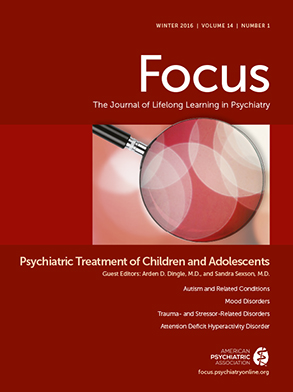Major depressive disorder is an enduring and impairing condition that can affect children as young as preschoolers and increases in frequency with age (
1,
2). The clinical presentation in youths may be characterized by irritable and angry mood rather than persistent sadness, and it may include a lack of attaining expected weight rather than losing weight (
2). Early onset of major depressive disorder is associated with a greater number of episodes over time, higher risk of suicidal thoughts, more comorbid disorders, and decreased contribution of genetic factors (
1–
3). Overall heritability of major depressive disorder is estimated to be approximately 35%, with increasing genetic influence proportional to age of onset (
3). The impact of adverse and traumatic experiences on the development of major depressive disorder in youths is mediated by gene-environment interactions (i.e., the product of an individual’s genetic vulnerability and the adversity experienced) (
1). Major depressive disorder in children and adolescents may lead to persisting social, emotional, and cognitive impairments, making early identification, treatment, and prevention a high priority (
4,
5).
Treatment
There is an increasing body of published literature on evidence-based psychotherapeutic and pharmacological treatments alone and in combination for major depressive disorder among youths; however, best-practice recommendations still include expert clinical consensus (
2,
4,
20). Cognitive-behavioral therapy (CBT) has the most evidence of efficacy among youths with major depressive disorder, with trials with large sample sizes and consistent moderate effect sizes (
2,
4,
21). Interpersonal therapy (IPT) is supported by some evidence from three randomized controlled trials (
22,
23) and from one randomized but uncontrolled study comparing IPT with a form of CBT with patients with early-onset chronic depression (
24).
The update of the Texas Children’s Medication Algorithm Project (
20) recommends that effective interventions for milder forms of depression among youths without risk of suicidal thoughts or behaviors include supportive, psychodynamic, family therapy, and psychoeducation.
For youths with moderate to more serious forms of major depressive disorder, the decision to treat with selective serotonin reuptake inhibitors (SSRIs), CBT, or both involves consideration of the severity of the depression, the immediate risk of suicidal behavior, family history of major depressive disorder and treatment responses, and whether the depression is recurrent (
2,
4,
10,
20).
SSRIs are the first line of evidence-based pharmacological treatment for depression, and a meta-analysis showed an average response rate of 60% for SSRIs and 49% for placebo (
2,
4,
10). Efficacious SSRIs include fluoxetine, sertraline, citalopram, paroxetine, and venlafaxine (
2). High rates of placebo response for major depressive disorder among youths have made it more difficult to show efficacy of medications (
2,
4,
10). The U.S. Food and Drug Administration has approved fluoxetine and escitalopram (for patients ages >8 and >12 years, respectively) in the acute and maintenance treatment of depression (
2).
Concerns regarding the increased rates of suicidal thoughts, but not completed suicide, among adolescents treated with SSRIs in clinical trials compared with placebo have been mitigated by a meta-analysis indicating that the benefits of SSRI treatments far outweigh the risks of untreated depression (
2,
10,
25). A meta-analysis of clinical trials for adolescent depression with newer-generation antidepressants (
26) showed no advantage over SSRIs; therefore, fluoxetine, sertraline, and other SSRIs are still first-line treatments (
2,
4,
10). To our knowledge, there are no controlled trials of bupropion or mirtazapine with children or adolescents, and trials have not shown efficacy of tricyclic antidepressants nefazodone or duloxetine in the treatment of major depressive disorder in youth (
2).
Several large, multisite, randomized controlled studies have investigated the efficacy of SSRI antidepressants, CBT, and the combination CBT and SSRIs for youths with moderate to severe depression.
The Treatment for Adolescents With Depression Study (TADS) (
27,
28) consisted of a 12-week trial in 439 individuals (ages 12–17 years) with major depressive disorder. Participants were randomly assigned to one of four treatment groups: fluoxetine alone (10–40 mg/day), CBT alone, CBT with fluoxetine (10–40 mg/day), or placebo (equivalent to 10–40 mg/day). The TADS results at 12 weeks, using the Children’s Depression Rating Scale–Revised (
29), showed the combination of CBT with fluoxetine to be statistically significantly more efficacious compared with placebo and superior to fluoxetine alone and CBT alone (
27). Fluoxetine alone was found to be superior to CBT alone at 12 weeks (
27) (
Table 1).
Using the improvement scale of the Clinical Global Impressions Scale (CGI-I) (
30), both of the fluoxetine conditions were statistically significantly superior to the CBT and the placebo conditions (
27).Predictors of response in the TADS study included younger age, less chronic depression or hopelessness, less suicidal ideation, and greater expectations for improvement (
31). Combined CBT with fluoxetine was more effective than fluoxetine alone only for adolescents with mild or moderate depression and for those exhibiting cognitive distortions, but not for those with more severe depression (
31). However, using intention-to-treat analyses, treatments were similarly efficacious on follow-up of active TADS treatment groups at 18 and 36 weeks (
28) (
Table 2). TADS longitudinal data also showed that adolescents treated with combination treatment or CBT alone were less likely to experience suicidal ideation than those treated with fluoxetine alone (
28,
32).
The second large study, the Adolescent Depression Antidepressant and Psychotherapy Trial (ADAPT) (
33), was conducted in the United Kingdom. ADAPT was a 12-week randomized controlled (unblinded) trial with youths ages 11–17 who had major depressive disorder, followed by a 16-week maintenance phase. Fluoxetine was the primary SSRI chosen. ADAPT (
33), in contrast with the TADS study (
24), included youths with active suicidality, depressive psychotic symptoms, and conduct disorder (
33). All ADAPT adolescents received “routine specialist clinical care,” which focused on psychoeducation and attention to family and peer conflicts. Participants were divided into two treatment groups (
33,
34): SSRI and routine specialist clinical care (N=103), and SSRI and routine specialist clinical care and CBT (N=105). The main outcome measure was a change in the score on the Health of the Nation Outcome Scales (
35).
Response rates using odds ratios for CGI-I scores for the two conditions at 6, 12, and 28 weeks are shown in
Table 3. The ADAPT researchers concluded that routine specialist clinical care plus SSRI treatment was equally efficacious with or without the addition of CBT (
33,
34). A weakness of ADAPT was the absence of a placebo group; however, this study’s strength was the inclusion of adolescents with comorbidity, suicidal ideation, and psychosis (
33,
34)
At 28 weeks, 23% of ADAPT participants remained depressed (
33). Predictors of poor response included the severity of depression, suicidal ideation at study entry, comorbid obsessive-compulsive disorder at entry, and at least one adverse life event during the follow-up period (
36).
In contrast with a lack of increased efficacy found in adding CBT to antidepressants in the most severely depressed adolescents in both the TADS (
27) and ADAPT (
33) studies, combining CBT with antidepressants proved more efficacious than medication alone in the Treatment of Resistant Depression in Adolescents (TORDIA) study (
37).
The TORDIA (
37) study was a 12-week randomized controlled trial of 334 adolescents with depression (ages 12−18 years), all of whom had unsuccessful previous SSRI treatment. These adolescents were randomly assigned to one of four treatment groups: switch to a second different SSRI (including fluoxetine, paroxetine, or citalopram 20–40 mg/day), switch to a different SSRI plus CBT, switch to venlafaxine (150–225 mg/day), or switch to venlafaxine plus CBT. Both CBT groups showed better response at week 12 (54.8%) than those without CBT (40.5%). Response rates of TORDIA study completers by group are shown in
Table 4.
The TORDIA study investigators found that 50% of participants who did not respond to a first SSRI treatment responded to a second treatment (
37). Evidence also suggests that combination treatment for adolescents with treatment-resistant major depressive disorder may add to prevention of relapse (
38).
Approximately 60% of depressed adolescents have responded to their first SSRI trial (
25), and one-half of these individuals can be expected to respond to a second SSRI; therefore, after two antidepressant trials, treatment resistance continues to be an issue for 20% of youths with depression (
2,
38). Although randomized controlled trials investigating duloxetine in adolescent depression have been negative (possibly owing to the high placebo response), agents such as bupropion or duloxetine may be tried when depression is resistant to treatment with SSRIs. In cases of partial response to SSRIs, augmentation with another antidepressant is considered (
20,
38,
39)

